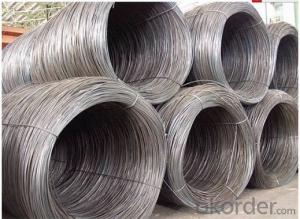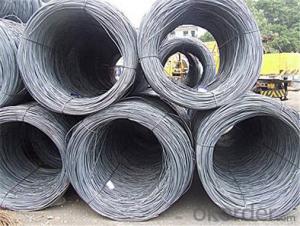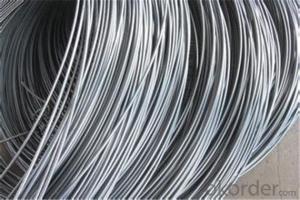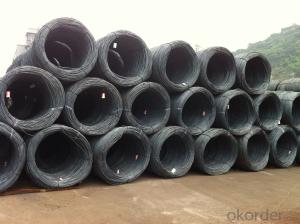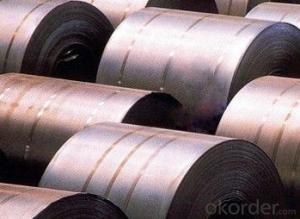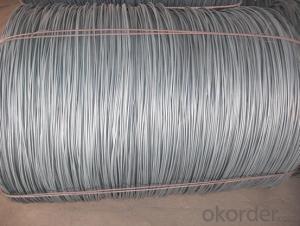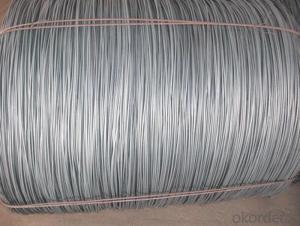SAE1006B Steel Wire Rod 6.5mm with in China
- Loading Port:
- Tianjin
- Payment Terms:
- TT OR LC
- Min Order Qty:
- 500 m.t.
- Supply Capability:
- 45555555 m.t./month
OKorder Service Pledge
OKorder Financial Service
You Might Also Like
Item specifice
Description of wire Rod:
Our company is recognized by ISO9001:2008
1. hot rolled wire rod
2. material: Q195-235
3. payment: T/T or L/C
4.size: 5mm-19mm
Festures of wire Rod:
1. Drawn wire specialist, your wire rod solution
2. ISO9001 Certified Mill &SGS
3. Feature: machinability, high hardness, toughness, corrosion resistant
4. Clear and smooth surface, high precision and Tolerance control: ± 0.01
Specifications of wire Rod:
Product | steel wire rod |
Standard | AISI, ASTM, BS, DIN, GB, JIS |
Material/steel grade | Q195-Q235,SAE1006, SAE1008, SAE1010, SAE1018, SAE1020 or according to customers requirements |
Wire Gauge | 5.5-12mm |
Coil weight | 1.8-2.1mts |
MOQ | 25MT |
Delivery Time | 15-30 days after receipt of L/C or deposit by T/T |
Packing | In coil and load in container, if large quantity, by bulk vessel; Can be packed as customers' special requirements |
Payment terms | 1).100% irrevocable L/C at sight. |
Application | widely used in machinery parts, manufacturing industry, electronics industry, metal tools and others |
Images of wire Rod:
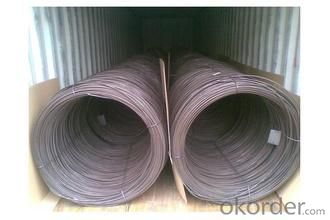
FAQ:
1. What is your package?
Packing situation: standard seaworthy packing or as customer required.
2. How long is the lead time?
Delivery time: 45 days after order confirmed.
3. What payment term do you accept?
Payment: T/T or L/C at sight.
- Q:What are the different types of steel wire rod coatings used for anti-corrosion properties?
- Steel wire rod coatings are commonly used to prevent corrosion. There are various types of coatings available for this purpose. 1. Zinc Coatings: Zinc coatings, like galvanized coatings, are widely used for their anti-corrosion properties. These coatings create a protective layer of zinc on the steel wire rod surface, acting as a barrier against corrosion. Zinc coatings can be applied through hot-dip galvanizing or electroplating. 2. Aluminum Coatings: Another type of coating used for anti-corrosion is aluminum coatings. These coatings can be applied through hot-dip aluminizing or thermal spraying. They form a protective layer that prevents contact between the steel wire rod and corrosive substances. 3. Epoxy Coatings: Epoxy coatings, a type of organic coating, are commonly used for anti-corrosion purposes. They are applied as a liquid and then cured to create a hard and durable protective layer on the steel wire rod surface. Epoxy coatings offer excellent resistance against corrosion and can withstand harsh environments. 4. Polymer Coatings: Polymer coatings, such as polyethylene or polypropylene coatings, are frequently used for anti-corrosion properties. These coatings are typically applied through extrusion or powder coating. Polymer coatings provide a protective layer that is resistant to chemicals, moisture, and other corrosive elements. 5. Ceramic Coatings: Ceramic coatings are highly resistant to corrosion and wear. They are applied through thermal spraying or chemical vapor deposition. Ceramic coatings create a hard and dense layer on the steel wire rod surface, offering excellent protection against corrosion. Choosing the right coating depends on factors such as the environment, operating conditions, and desired level of corrosion resistance. Each type of coating has its own advantages and limitations, so it is crucial to select the most suitable one for long-term anti-corrosion protection of the steel wire rod.
- Q:What are the environmental benefits of recycling steel wire rod?
- Recycling steel wire rod provides various benefits to the environment. The foremost advantage is the conservation of natural resources. By recycling steel, we can decrease the necessity for extracting and mining iron ore, which is the primary raw material utilized in steel production. This lessens the environmental impact of mining activities, which encompass deforestation, habitat destruction, and soil erosion. Moreover, recycling steel wire rod aids in reducing energy consumption and greenhouse gas emissions. The production of steel from recycled materials requires considerably less energy compared to the production from virgin materials. Additionally, the recycling process emits fewer greenhouse gases, such as carbon dioxide, in comparison to manufacturing steel from scratch. By recycling steel wire rod, we can help mitigate climate change and diminish our carbon footprint. Furthermore, recycling steel wire rod assists in waste reduction and conserves landfill space. Steel is a long-lasting material that can be recycled indefinitely without losing its properties. By recycling steel wire rod, we can divert this material from ending up in landfills, where it would occupy valuable space and contribute to pollution. Additionally, recycling steel wire rod diminishes the necessity for new steel production, which can result in waste generation and environmental pollution during the manufacturing process. Lastly, recycling steel wire rod aids in safeguarding ecosystems and wildlife. Mining activities for iron ore extraction can have devastating effects on ecosystems, including forest destruction, water source contamination, and disruption of wildlife habitats. By reducing the demand for new steel production through recycling, we can minimize the negative impacts on ecosystems and preserve biodiversity. In conclusion, recycling steel wire rod presents numerous environmental benefits, such as the conservation of natural resources, reduction in energy consumption and greenhouse gas emissions, waste reduction, and protection of ecosystems and wildlife. By opting to recycle steel wire rod, we can contribute to a more sustainable and eco-friendly future.
- Q:How does the manufacturing process of steel wire rod impact its mechanical properties?
- The manufacturing process of steel wire rod can significantly impact its mechanical properties. The choice of raw materials, such as the type and quality of steel used, along with the processing techniques employed, can influence the wire rod's strength, ductility, and other mechanical characteristics. Factors like the casting method, rolling or drawing processes, and heat treatment can all affect the microstructure of the wire rod, which in turn affects its strength, toughness, and other properties. Therefore, careful control and optimization of the manufacturing process are crucial in ensuring the desired mechanical properties of steel wire rod are achieved.
- Q:What are the common applications of low carbon steel wire rod?
- Due to its advantageous properties, low carbon steel wire rod finds extensive use across a wide range of applications. Some common uses of this wire rod include: 1. Construction: The construction industry widely employs low carbon steel wire rod for various purposes. It is commonly utilized to reinforce concrete structures like beams, columns, and slabs. The wire rod's high tensile strength and ductility make it an ideal choice for reinforcement. 2. Manufacturing: Various manufacturing industries extensively utilize low carbon steel wire rod in the production of different products. It is commonly employed in manufacturing nails, screws, bolts, and other fasteners due to its exceptional formability and strength. Additionally, wire mesh, wire ropes, and cables are produced using this wire rod. 3. Automotive industry: The automotive industry also utilizes low carbon steel wire rod for various applications. It is employed in the manufacturing of parts such as springs, suspension systems, and tire cords. The wire rod's flexibility, strength, and durability make it suitable for these applications. 4. Agriculture: In the agricultural sector, low carbon steel wire rod is commonly used for constructing fences and wire mesh. It imparts durability and strength to fencing systems, ensuring the security of livestock and crops. Additionally, it is utilized for making trellises and support structures for plants. 5. Household applications: Low carbon steel wire rod also finds use in various household applications. It is employed in the production of hangers, racks, and shelves due to its ability to withstand heavy loads. Additionally, kitchen utensils, wire baskets, and other household items are manufactured using this wire rod. In summary, low carbon steel wire rod is a versatile material that finds application in diverse industries and contexts. Its properties, including formability, strength, and durability, establish it as the preferred choice for numerous manufacturing and construction purposes.
- Q:What are the main factors affecting the market research of steel wire rod?
- The main factors affecting the market research of steel wire rod include supply and demand dynamics, price fluctuations, industry regulations, technological advancements, competitor analysis, and consumer preferences. Additionally, factors like raw material availability, production capacity, global economic conditions, and geopolitical events also play a significant role in influencing the market research of steel wire rod.
- Q:How is steel wire rod used in the manufacturing of wire for springs in mattresses?
- Steel wire rod is used in the manufacturing of wire for springs in mattresses as it serves as the primary material for creating the springs. The wire rod is first drawn and stretched to the desired thickness and then coiled into springs of various sizes and shapes. These springs are then interconnected to form the core structure of the mattress, providing support and resilience. The high tensile strength and durability of steel wire rod make it an ideal choice for ensuring the longevity and comfort of the mattress.
- Q:How is steel wire rod used in the manufacturing of clothes hangers?
- Steel wire rod is used in the manufacturing of clothes hangers as it provides the necessary strength and durability required to hold and support garments without bending or breaking. The wire rod is formed into the desired shape and size, allowing it to be easily molded into the traditional hanger design. Additionally, the smooth surface of the steel wire rod prevents any damage or snagging to the clothes, ensuring they remain in good condition.
- Q:What are the common production processes for francium-coated steel wire rod?
- The common production processes for francium-coated steel wire rod typically involve several steps. Firstly, the steel wire rod undergoes cleaning and pre-treatment to remove any impurities and ensure a smooth surface. Then, a layer of francium is applied to the steel wire rod through a specialized coating process, which may involve techniques like electroplating or physical vapor deposition. After the francium coating is applied, the wire rod is usually subjected to curing or annealing processes to enhance the adhesion and durability of the coating. Finally, the coated wire rod is inspected for quality control purposes before it is ready for further use in various applications.
- Q:How is steel wire rod tested for uniformity of coating?
- Steel wire rod is tested for uniformity of coating through various methods. One common approach is to visually inspect the wire rod to check for any visible inconsistencies or irregularities in the coating. Additionally, the rod can be subjected to coating thickness measurement tests using techniques such as magnetic induction or eddy current methods. These measurements help determine if the coating thickness is consistent throughout the wire rod. Other tests may involve conducting adhesion tests to evaluate the bond strength between the coating and the wire rod surface. Overall, a combination of visual inspection and specialized testing methods is employed to ensure the uniformity of coating on steel wire rods.
- Q:What are the major steel wire rod consuming countries?
- The major steel wire rod consuming countries include China, the United States, Japan, India, and South Korea.
1. Manufacturer Overview |
|
|---|---|
| Location | |
| Year Established | |
| Annual Output Value | |
| Main Markets | |
| Company Certifications | |
2. Manufacturer Certificates |
|
|---|---|
| a) Certification Name | |
| Range | |
| Reference | |
| Validity Period | |
3. Manufacturer Capability |
|
|---|---|
| a)Trade Capacity | |
| Nearest Port | |
| Export Percentage | |
| No.of Employees in Trade Department | |
| Language Spoken: | |
| b)Factory Information | |
| Factory Size: | |
| No. of Production Lines | |
| Contract Manufacturing | |
| Product Price Range | |
Send your message to us
SAE1006B Steel Wire Rod 6.5mm with in China
- Loading Port:
- Tianjin
- Payment Terms:
- TT OR LC
- Min Order Qty:
- 500 m.t.
- Supply Capability:
- 45555555 m.t./month
OKorder Service Pledge
OKorder Financial Service
Similar products
New products
Hot products
Hot Searches
Related keywords
